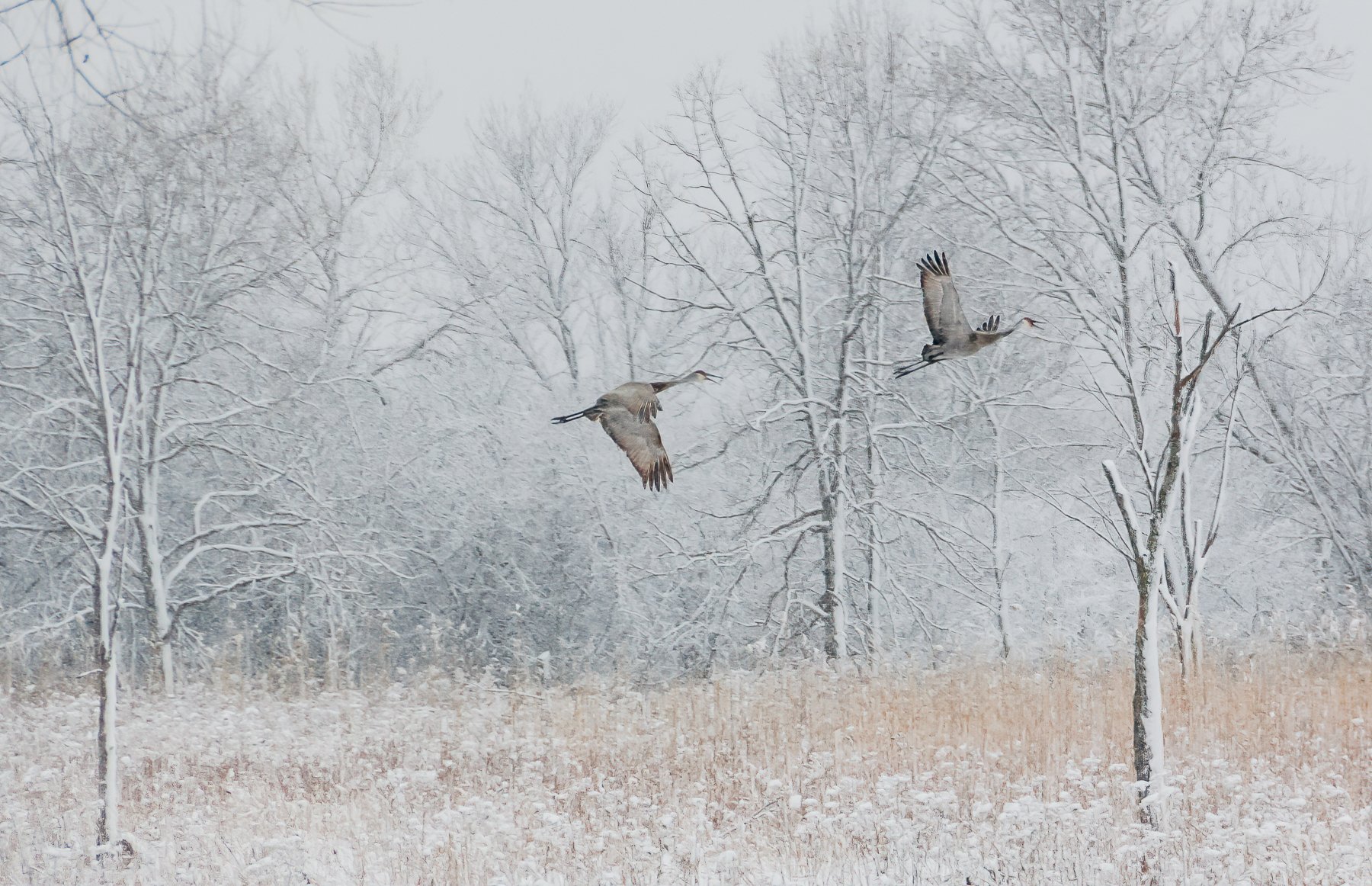“The cranes are back! Did you hear them yesterday?” I love this typical Wisconsin spring greeting.
In A Sand County Almanac chapter “Marshland Elegy,” Aldo Leopold describes:
“High horns, low horns, silence, and finally a pandemonium of trumpets, rattles, croaks, and cries that almost shakes the bog with its nearness, but without yet disclosing whence it comes. At last a glint of sun reveals the approach of a great echelon of birds.”
Calling on a spring day (photo by Gary Shackelford).
For the past ten years, our first sight and sound of Sandhill Cranes at Fair Meadows has been a gentle unison call and the graceful glide of a pair descending into the sedge meadow south of our house. Upon arrival, they are light gray, but will soon paint their feathers with the mud of the wetlands to become the rust color that blends with the sedges. According to Birds of the World, the earliest cranes to return in the spring are often mated pairs. Sandhill Cranes form strong pair bonds and usually mate for life. However, if one member of the pair is lost, or a nest fails, re-pairing occurs quickly.
Each spring for 25 years, we have participated in the Annual Midwest Crane Count. To arrive at the marsh by 5:30 a.m., we set out from the barn in the dark and frequently hear and flush woodcocks on our way through the prairies. For two hours, we count all the cranes that we see. Over the years counts have ranged from 11 to 101. Counts for the past four years were 11, 59, 64, 17.
At Fair Meadows, four nest locations are regularly distributed within the 200 acres that are easily accessible on the eastern portion of the property. More nests are scattered in the remaining 160 acres of sedge meadow and emergent marsh that are not accessible to those without wings or webbed feet.
Sandhill Cranes in a spring snowstorm at Fair Meadows on March 27, 2008 (photo by Gary Shackelford).
This year, the magical day of arrival was February 15, not unusually early for the pair that is eager to arrive and defend their favorite nesting territory near the house (arrivals in previous years ranged from February 14 to March 11). The only problem with early arrival is the possibility of a spring snowstorm or a spell of very cold weather. Interestingly, our last sighting of cranes migrating south this year was only four weeks earlier, on January 13. Gary was outside exploring the deep snow that had fallen on January 11 and 12 and he heard the cacophony of a large flock of cranes. Approximately 200 birds—arranged in groups of 20 to 30—were heading south. The Wisconsin Phenology Calendar published by the Aldo Leopold Foundation notes January 30 as the day when “the last of Sandhill Cranes begin migrating south” and February 13 as “Sandhill Cranes begin to arrive.”
A crane at the door (photo by Gary Shackelford).
Before beginning to nest, the pair spends time warding off other cranes that might fly overhead and checking out the three or four favorite tussocks of sedge where they have nested in past years. They stroll around our house and barn, feed in the eight-acre prairie south of the house, and then fly off together in the direction of the marsh. On several occasions, they have stopped and tapped on the front door! We’d like to think they are telling us about their arrival, but they are probably challenging the reflection that they see in the glass. It’s a surprise to hear a knock at the door and see this.
We know nesting has begun when we see only one crane at a time, often standing guard in the area. We eagerly await the day when fuzzy red colts (the word for young cranes) appear with their parents, always walking between them. The colts grow at the same rate as the plants in the freshly burned prairie, so their little heads are always at plant-top level. By the end of the summer, they are as tall as the adults, right up there with the Indian grass.
A crane and a deer share the prairie (photo by Gary Shackelford).
In the prairie near the house, there is a slight ridge with a wet swale below it. This is a favorite spot for the family to feed and rest in the warmer seasons. One year, a doe and fawn got attached to the same area and after some negotiation, they bedded down together for several weeks. During the past two years, we have spotted the crane family spending the night in the same location under the baptisia plants. Each evening, as dusk falls, the colts would lie down, and the parents would continue to feed until dark.
Written by Penny Shackelford, Fair Meadows Sanctuary resident manager
Cover image by Gary Shackelford. Sandhill Crane in flight showing painted feathers.









